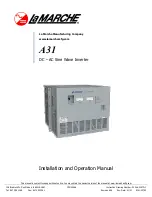
Country-
spec. Set-
tings
Men
u
level
Display/
Setting
Action in this menu/meaning
Lock-out voltage
23 V – 287 V
The control is deactivated below this voltage.
Number of nodes
2 – 10
Specify the number of nodes for the cos φ/(p/pn) characteristic curve
1st node … 10th node
Voltage | Reactive
power | Excitation
0 – 100 [% S
max
]
Power of the node as a percentage of the maximum power.
For the 1st node, the power must be 0%; for the last node, the power
must be 100%. The power values of the nodes must increase continu-
ously.
Note: Storage inverters only for feed-in operation
0 – 100 %
cos φ of the node
Over-excited | un-
der-excited
Reactive power mode Under-excited relates to inductive load, over-ex-
cited relates to capacitive load.
Q(U) 10 nodes
Lock-in power
0 – 100 [% S
max
]
Power threshold, function is activated if limit value is exceeded.
Lock-out power
0 – 100 [% S
max
]
Power threshold, function is activated if limit value is undershot.
Lock-in time
0 – 60 [s]
Length of time that the active power must remain below the lock-in
power level before control is deactivated.
Lock-out time
0 – 60 [s]
Length of time that the active power must remain below the lock-out
power level before control is deactivated.
4
1
2
3
4
Downtime
0s – 10s
F
Set the intentional delay for the start of the Q(U) function.
NOTE: If the voltage switches from a characteristic curve section with
Q=0 to a characteristic curve section with Q≠0 under active control,
then the reactive power setting process is delayed by the set dead
time. Once the dead time has expired, the control circuit is no longer
subject to a delay and the set settling time determines the transient
behavior.
Rise Outg. grad. & Fall.
Outg. grad.
increasing | decreas-
ing
In addition to configuring the dynamic behaviour using the transient
time corresponding to a first-order filter, the reactive power setting can
be determined by a maximum gradient - this means the maximum
change in the reactive power per time period.
1 – 60000 [% S
max
/
min]
Maximum change in the reactive power %S
N
/min in the event of a
change to over-excited mode
NOTE: The gradient is overlaid with the settling time.
Min. cos-phi Q1 - Min.
cos-phi Q4
In the event of a significant voltage deviation, the maximum reactive
power adjustment range can be limited by a minimum cos φ factor in
order to prevent an excessive reactive power supply and, as a result, a
significant reduction in the maximum active power that can be fed in.
Q1
Minimum cos φ in over-excited operating mode (in-feed).
Q4
Minimum cos φ in under-excited operating mode (in-feed).
Q2
Minimum cos φ in over-excited operating mode (charge).
Q3
Minimum cos φ in over-excited operating mode (charge).
KACO blueplanet 87.0 TL3 KACO blueplanet 92.0 TL3 KACO blueplanet 110 TL3 KACO blueplanet 125 TL3
KACO blueplanet 137 TL3 KACO blueplanet 150 TL3
Page 76
EN-US
















































